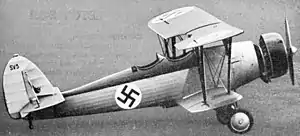Stampe et Vertongen SV.5 Tornado
The Stampe et Vertongen SV.5 Tornado was a military trainer aircraft designed and built in Belgium in the 1930s.[4][5] It saw service with the Belgian Air Force[6] and Latvian Air Force,[7] and Latvian firm VEF purchased a production license, although it is uncertain whether it built any examples.[6]
| SV.5 Tornado | |
|---|---|
 | |
| A Latvian Air Force SV.5 | |
| Role | Military trainer |
| National origin | Belgium |
| Manufacturer | Stampe et Vertongen |
| Designer | George Ivanow[1] |
| First flight | September 1933[2] |
| Primary user | Belgian Air Force[3] |
| Number built | 31, plus one SV.9[3] |
Design and development
The SV.5 was Stampe et Vertongen's response to a 1933 requirement by the Belgian Air Force for a two-seat training biplane with aerobatic capabilities.[1] Jean Stampe directed designer George Ivanow to update the company's RSV.22 to meet the new specifications, but the resulting design was an entirely new aircraft with only a superficial resemblance to its predecessor.[1] It was a conventional, single-bay biplane with staggered wings of unequal span.[8] The pilot and instructor sat in open cockpits in tandem[8] and the aircraft was powered by an Armstrong Siddeley Serval radial engine[9] in the nose, enclosed in a Townend ring.[7] The main units of the fixed undercarriage were divided and the tail was supported by a tailwheel.[8] It could be equipped for bombing or gunnery training.[5] Unlike earlier Stampe et Vertongen products, which had wooden structures, the SV.5 airframe was riveted together from steel tube in a method inspired by Hawker in the United Kingdom.[1]
The prototype first flew in September 1933,[2] and on 16 October 1934, the Belgian Air Force evaluated it against five competitors: the Avro 626, Breda Ba.25, Fairey Fox III, LACAB T-7, and the Renard R-34.[7] A sixth competitor, the Caproni Ca.113, suffered an accident on arrival and was disqualified.[7] The SV.5 outclassed all its rivals in the maintainability trials, and was less expensive than any of them.[7] However, the Avro 626 was selected for political reasons.[7]
The SV.5 nevertheless found a customer in the Latvian Air Force, which was seeking a similar aircraft.[7] When a study mission to Belgium confirmed the type's suitability, the Latvian government negotiated the purchase of ten examples in exchange for 5,700 tonnes of wheat.[7] These machines were slightly different from the prototype, with a NACA cowl in place of the Townend ring, a redesigned horizontal stabiliser, and simplified main undercarriage.[7] Germany would not permit the overflight of the aircraft, so in September 1936 they were shipped disassembled to Riga, where Jean Stampe oversaw their assembly by VEF.[6]
In the meantime, the Belgian Air Force finally placed an order for twenty SV.5s.[6] Stampe et Vertongen delivered these between October 1936 and mid 1937.[6]
Variants
Ivanow used the SV.5 as the basis for a family of follow-on designs with only minor variations:[6]
- SV.6
- version with 260-kW (350-hp) Armstrong Siddeley Cheetah IX
- SV.7
- version with 378-kW (507-hp) Pratt & Whitney Wasp Junior, also with spoilers under the upper wing
- SV.8
- version with 180-kW (240-hp) Armstrong Siddeley Lynx IV
- SV.9
- SV.5 with metal, variable-pitch propeller, and upper wings moved 2 cm (1 in) rearward to improve centre of gravity
Of these, only a single SV.9 was built. This aircraft was exported to Latvia, together with a license for production by VEF. Although rumours exist that VEF built examples of the type, this cannot be confirmed.[6]
Specifications (SV.5)
Data from Jouhaud 1999, p.86
General characteristics
- Crew: two
- Length: 8.04 m (26 ft 4 in)
- Wingspan: 10.52 m (34 ft 6 in)
- Height: 3.04 m (10 ft 0 in)
- Wing area: 26.7 m2 (287 sq ft)
- Empty weight: 890 kg (1,960 lb)
- Gross weight: 1,340 kg (2,950 lb)
- Powerplant: 1 × Armstrong Siddeley Cheetah X , 250 kW (340 hp)
Performance
- Maximum speed: 272 km/h (151 mph, 131 kn)
- Endurance: 3 hours 30 minutes
- Service ceiling: 7,150 m (23,500 ft)
Notes
- Jouhaud 1999, p.82
- Jouhaud 1999, p.88
- Jouhaud 1999, p.82–85
- Taylor 1989, p.839
- The Illustrated Encyclopedia of Aircraft, p.2955
- Jouhaud 1999, p.85
- Jouhaud 1999, p.84
- Jouhaud 1999, p.87
- Jouhaud 1999, p.83
References
- The Illustrated Encyclopedia of Aircraft. London: Aerospace Publishing.
- Gerdessen, Frederik. "Estonian Air Power 1918 – 1945". Air Enthusiast, No. 18, April – July 1982. pp. 61–76. ISSN 0143-5450.
- Jouhaud, Reginald (1999). Les Avions Stampe. Amsterdam: Wimpel.
- Taylor, Michael J. H. (1989). Jane's Encyclopedia of Aviation. London: Studio Editions.